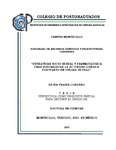| dc.description.abstract | Se realizaron tres estudios para determinar la respuesta reproductiva y productiva postparto de ovejas de pelo al uso de “efecto macho” y a un protocolo de inducción del estro con la aplicación de un reconstituyente metabólico (R; Metabolice®) y Somatotropina bovina recombinante (rBST; Boostin-S®). En el primer estudio, 120 hembras y sus corderos, fueron asignados al azar a T1: Amamantamiento continuo (AC; n = 29), T2: AC+R (n = 29), T3: AC+Efecto Macho (EM; n = 32) y T4: AC+R+EM (n = 30). En el segundo, 94 hembras y sus corderos fueron asignados al azar a T1: AC (n = 29), T2: AC+R (n = 29), T3: AC+rBST (n = 17) y T4: R+rBST (n = 19). En el tercero, 97 hembras y sus corderos fueron asignados al azar a T1: AC (n = 29), T2: AC+EM (n = 32), T3: AC+rBST (n = 17) y T4: AC+EM+rBST (T4; n = 19). Se observó el porcentaje de ovulación a los 29 y 50 días postparto, cambios de peso en ovejas y corderos, incidencia e inicio del estro, retorno, fertilidad, gestación, parición, fecundidad y prolificidad. Para el primer estudio, el porcentaje de ovulación a los 29 días fue mayor para T3 y T4. Los cambios de peso en ovejas y corderos fueron diferentes en los periodos. El inicio del estro fue menor para T1 y T2. Gestación y parición fue mayor para T2. Para el estudio dos, el porcentaje de ovulación a los 29 días fue mayor para T4. A los 50 días fue mayor T1 y T2. El cambio de peso corporal fue diferente para tratamientos en corderos y periodo e interacción tratamiento por periodo en ovejas y corderos. T3 fue menor para incidencia, inicio del estro y fertilidad, pero mayor para retorno. T2 fue mayor para gestación, parición y fecundidad. Para el estudio tres, los mayores porcentajes de ovulación a los 29 días fueron para T2 y T4. A los 50 días, fueron mayores y similares T1, T2 y T4. El cambio de peso corporal fue diferente para tratamientos en corderos y periodo e interacción tratamiento por periodo en ovejas y corderos. Para incidencia y fecundidad T3 fue menor. El inicio del estro fue igual y menor para T1 y T4. El “efecto macho” durante 25 días influyó para restablecer la actividad ovárica de las ovejas en anestro postparto antes de los 29 días. El uso de un reconstituyente metabólico, puede utilizarse para mejorar la eficiencia reproductiva de las ovejas dentro de un protocolo de inducción del estro por cinco días, sin afectar los pesos de ovejas y corderos. La aplicación de rBST en general afecta las variables reproductivas y el peso corporal de las ovejas, pero mejora el peso corporal de los corderos. _______________ STRATEGY SOCIO SEXUAL AND PHARMACOLOGICAL TO RESTORE OVARIAN ACTIVITY POSTPARTUM IN HAIR SHEEP. ABSTRACT: Three studies were conducted to determine the postpartum reproductive and productive response of hair sheep to the use of " male effect " and a protocol for induction of estrus with the implementation of a metabolic tonic ( R; Metabolase® ) and recombinant bovine somatotropin ( rBST ; BOOSTIN - S® ). In the first study , 120 females and their lambs were randomly assigned to T1: continuous suckling ( AC ; n = 29 ) , T2 : AC + R ( n = 29 ) , T3 : AC + Effect Male ( EM ; n = 32 ) and T4 : AC + R + MS ( n = 30) . In the second, 94 females and their lambs were randomly assigned to T1 : AC ( n = 29 ) , T2 : AC + R ( n = 29 ) , T3 : AC + rBST ( n = 17) and T4 : R + rBST ( n = 19) . In the third, 97 females and their lambs were randomly assigned to T1 : AC ( n = 29 ) , T2 : AC + MS ( n = 32 ) , T3 : AC + rBST ( n = 17) and T4 : AC + EM + rBST ( T4 ; n = 19). The ovulation rate was observed at 29 and 50 days postpartum weight changes in sheep and lambs, incidence and onset of estrus, return, fertility, gestation, parturition, fecundity and prolificacy. For the first study, the percentage of ovulation at 29 days was greater for T3 and T4. Weight changes in sheep and lambs were different in periods. The estrus was reduced to T1 and T2. Pregnancy and calving was higher for T2. For the study two, the ovulation rate at 29 days was higher for T4. At 50 days was higher T1 and T2. The body weight change was different in lambs and treatment period and interaction treatment period in sheep and lambs. T3 was lower for incidence, onset of estrus and fertility, but more to return. T2 was higher for pregnancy, calving and fecundity. For the study three, the highest percentages of ovulation at 29 days were for T2 and T4. At 50 days, they were higher and similar T1, T2 and T4. The body weight change was different in lambs and treatment period and interaction treatment period in sheep and lambs. For incidence and fecundity T3 was lower. The estrus was equal and lower for T1 and T4. The "male effect" for 25 days influenced to restore ovarian activity in postpartum anoestrus sheep before 29 days. Using a metabolic tonic, it can be used to improve reproductive efficiency of sheep within a protocol of induction of estrus for five days, without affecting the weights of sheep and lambs. The application of rBST generally affects reproductive variables and body weight of the sheep, but improves the body weight of the lambs. | es_MX |


